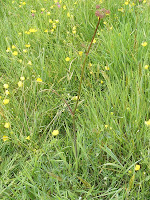To identify an umbel to species level you need to note the following:
- are the flowers white or yellow? (If they are yellow it narrows the choice of species down very considerably.)
- are the stems hollow or solid?
- are the stems spotted or tinged with red?
- are the stems ridged or smooth?
- are the stems hairy or hairless?
- does the plant have a distinctive smell?
- how divided are the leaves? Compare the leaf shape to illustrations in a field guide.
- Compare the seed pods to illustrations in a field guide. The seed pods of different species are quite easy to distinguish from one another.
- are there bracts (like small leaves) under the main or secondary umbels?
Scientific Name: Peucedanum palustre (syn. Thysselinum palustre)
English Name: Milk Parsley, Marsh Parsley, Hogs Fennel.
French Name: Peucédan des marais.
 5 Key Characters:
5 Key Characters:
Habitat: Calcareous fens, damp peaty grassland on the edges of neutral to alkaline marshland. Full sun or sometimes a little shade, in long grass, ditches, alder woods, reed beds.
Flowering Period: July-August-September.
Status: Protected. Rare and localised. Present in the Touraine and Brenne, but not in Vienne. Note that it is not an important host plant for the Swallowtail Papilio machaon in France.
Photographed by Loire Valley Nature:
Photographs numbered from left to right and top to bottom. 1 - 2 in damp pasture in the Brenne, May.
English Name: Milk Parsley, Marsh Parsley, Hogs Fennel.
French Name: Peucédan des marais.
 5 Key Characters:
5 Key Characters:- white flowers.
- leaf stems have a central groove.
- stems hollow, grooved and angled, often tinged red.
- no distinctive smell when crushed.
- bracts at the base of umbels.
Habitat: Calcareous fens, damp peaty grassland on the edges of neutral to alkaline marshland. Full sun or sometimes a little shade, in long grass, ditches, alder woods, reed beds.
Flowering Period: July-August-September.
Status: Protected. Rare and localised. Present in the Touraine and Brenne, but not in Vienne. Note that it is not an important host plant for the Swallowtail Papilio machaon in France.
Photographed by Loire Valley Nature:
Photographs numbered from left to right and top to bottom. 1 - 2 in damp pasture in the Brenne, May.








No comments:
Post a Comment